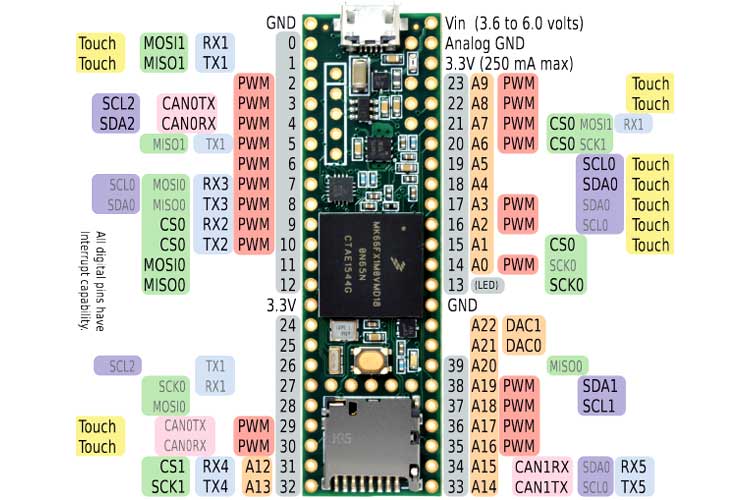TEENSY 3.6 Development Board
The Teensy 3.6 is a development board that has a 32-bit ARM Cortex M4 microcontroller that runs at 180MHz that can be programmed using the Arduino software.
Teensy 3.6 Pinout Configuration
|
Pin Category |
Pin Name |
Details |
|
Power |
VIN, 3.3V, Analog GND, GND |
VIN – Supply voltage pin when using an external power source (3.6V to 6.0V) 3.3V – Regulated output voltage from the onboard regulator (250mA max.) Analog GND – Acts as GND for the ADC and DAC, can be connected to GND GND – Ground pins |
|
Analog Pins |
A0 – A22 |
Pins A0 – A22 can act as analog inputs with 13-bit resolution Pins A21 and A22 act as DACs with 12-bit resolution |
|
Input/output pins |
D0 – D61 |
42 I/O pins breadboard friendly |
|
Serial |
· TX1, RX1 · TX2, RX2 · TX3, RX3 · TX4, RX4 |
2 serial ports have FIFO capability Fast baud rates |
|
External interrupts |
D0 – D61 |
All digital pins have interrupt capability |
|
PWM |
· D2 – D10 · D29 –D30 · D14 · D16 – D17 · D20 – D23 · D35 – D38 |
22 PWM pins total |
|
SPI |
· MISO0, MOSI0, SCK0, CS0 · MISO1, MOSI1, SCK1, CS0 |
2 SPI ports with FIFO |
|
Inbuilt LED |
D13 |
LED to act as a general-purpose GPIO indicator |
|
I2C |
· SCL0, SDA0 · SCL1, SDA1 · SCL2, SDA2 |
Inter-Integrated Circuit communication ports |
|
CAN |
· CAN0TX, CAN0RX · CAN1RX, CAN1TX |
CAN bus ports |
|
Touch sensing |
· D0 – D1 · D29 – D30 · D15 – D19 · D22 – D23 |
Can be used for capacitive touch sensing |
Teensy 3.6 Technical Specifications
|
Microcontroller |
MK66FX1M0VMD18 |
|
Operating voltage |
3.3V |
|
Recommended input voltage for VIN pin |
3.6V to 6.0V |
|
Analog inputs |
25 |
|
Digital I/O pins |
62 |
|
DC source/sink from I/O pins |
25mA |
|
Flash memory |
1M |
|
SRAM |
256KB |
|
EEPROM |
4KB |
|
Frequency (clock speed) |
180MHz |
|
Communication |
I2C, SPI, UART, CAN, USB |
Other Teensy Boards: Teensy LC, Teensy 3.2, Teensy 3.5
Other Development Boards: Arduino, STM32, ESP12, ESP32, Raspberry Pi, ESP8266
Teensy 3.6 vs Arduino Uno
|
Name |
Arduino Uno |
Teensy 3.6 |
|
Processor |
ATMega328P |
MK66FX1M0VMD18 |
|
Operating/input voltage |
5V |
3.3V |
|
CPU speed |
16MHz |
180MHz |
|
Analog pins |
8 |
25 |
|
Digital IO/PWM |
14 |
62 |
|
EEPROM/SRAM(KB) |
1/2 |
4/256 |
|
Flash |
32K |
1M |
|
USB Connector |
Mini |
Micro |
|
UART |
1 |
4 |
|
SPI |
1 |
2 |
|
I2C |
1 |
3 |
Teensy 3.6 vs Teensy 3.2
|
Name |
Teensy 3.2 |
Teensy 3.6 |
|
Processor |
MK20DX256 |
MK66FX1M0VMD18 |
|
Operating/input voltage |
3.3V |
3.3V |
|
CPU speed |
72MHz |
180MHz |
|
Analog pins |
21 |
25 |
|
Digital IO/PWM |
34 |
62 |
|
EEPROM/SRAM(KB) |
2/64 |
4/256 |
|
Flash |
256K |
1M |
|
USB Connector |
Micro |
Micro |
|
UART |
3 |
4 |
|
SPI |
1 |
2 |
|
I2C |
1 |
3 |
Understanding Teensy 3.6
The Teensy 3.6 is a 32-bit Arduino compatible development board that aims to bring ARM Cortex processing power into a breadboard-friendly package for hobbyist use.
Powering your Teensy 3.6:
There are three ways of powering your Teensy 3.6 development board:
- Using the built-in USB micro connector.
- Supplying a voltage of 3.6V to 6V from an external supply, possibly a 5V regulator. This method is recommended.
- Supplying 3.3V directly to the 3.3V pin. This method is not recommended since the supply line is directly connected to the microcontroller, any spikes or ripple might lead to damage.
Input/Output:
The Teensy 3.6 has 62 GPIO pins with a current sink/source ability of 25mA. Pull-up resistors can be enabled on the pins.
Most pins have extra functionality as well:
- Serial ports – receive and transmit data via the UART protocol
- I2C ports – two-wire communication via the IIC protocol
- SPI – fast serial communication
- PWM – output an 8-bit pulse width modulated square wave
- Pin 13 has a built-in LED
These special functions and their respective pins are illustrated in the Teensy 3.6 pin diagram shown above.
How To Use The Teensy 3.6
The Teensy 3.6 can be programmed using any C editor or the Arduino software, though the latter is quicker and easier for beginners.
The Arduino software download link can be found here:
https://www.arduino.cc/en/Main/Software
Once the software is downloaded and ready, the Teensy 3.6 is connected to the computer through the USB micro port.
Uploading Your First Program:
Select the correct board name (Teensy 3.6) in the Tools > Boards menu and select the correct COM port under Tools > Ports.
Since the built-in LED is on pin 13, just like the Arduino, the basic blink sketch will work on the Teensy 3.6. The code is shown below.
Applications
- Rapid prototyping
- Hardware-accelerated cryptography
- Robotics










